Updated: 19 Jul 2023
Where is Bai Dinh Pagoda?
Bai Dinh Pagoda is on Bai Dinh Moutain in Gia Sinh commune, Gia Vien district. This temple is about 100km from Hanoi capital, and only 12km from Ninh Binh center.
This pagoda covers an area of up to 539 hectares. This includes 27 hectares of the ancient Bai Dinh pagoda area and 80 hectares of the new Bai Dinh pagoda area.
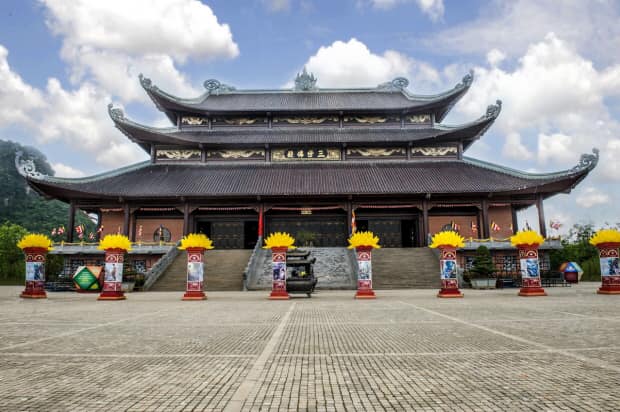 Bai Dinh Pagoda
Bai Dinh Pagoda
Why should you get to Bai Dinh Pagoda?
Coming to Bai Dinh Pagoda, you wwill discover many records of Vietnam as well as Southeast Asia:
- The largest pagoda in Vietnam.
- The pagoda has the largest bronze Buddha in Asia.
- The largest bronze Maitreya Buddha in Southeast Asia.
- The largest bronze bell in Vietnam.
- ...
What does Bai Dinh Pagoda have to attract tourist?
The Triple Gate of Bai Dinh Pagoda
In the journey to Bai Dinh pagoda in Ninh Binh, you will pass through the Tam Quan gate, with four Chinese characters "Minh top beauty". Legend has it that these are four words dedicated by King Le Thanh Tong (1460-1496) and a poem of four great words in Chinese.
This is a very beautiful and valuable Buddhist temple, worthy of being inscribed in the inscription engraved on the top of the bronze for everyone to know.
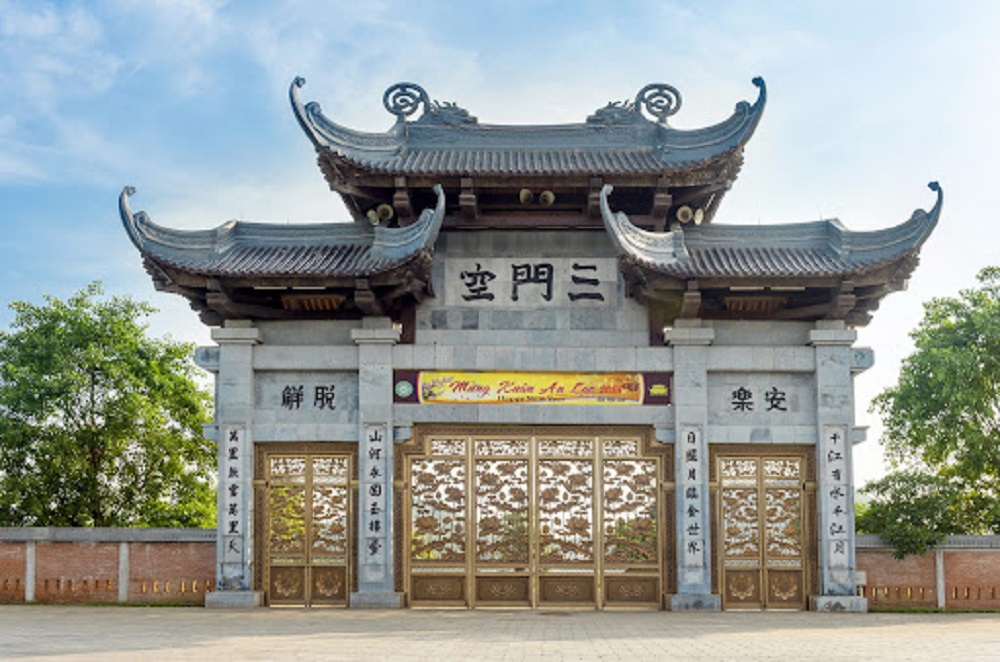 The Triple Gate of Bai Dinh Pagoda
The Triple Gate of Bai Dinh Pagoda
Arhat Corridor
This is a place you should not miss when going to Bai Dinh pagoda, which is the Arhat corridor including 234 compartments connecting the two ends of Tam Quan. This work has a length of up to 1052m with 500 statues of Arhats made from monolithic green stone weighing about 4 tons.
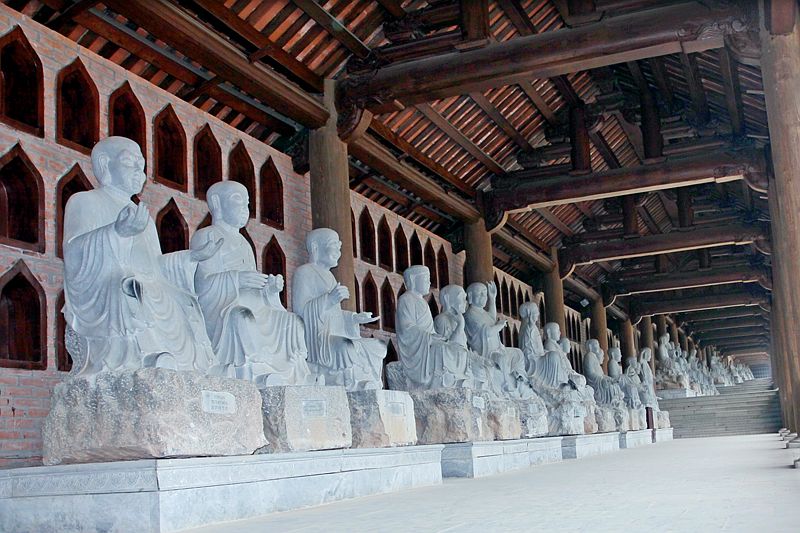 Arhat Corridor in Bai Dinh Pagoda
Arhat Corridor in Bai Dinh Pagoda
Bell Tower
Bell Tower is one of the famous works of the new Bai Dinh pagoda architecture. The tower is built of reinforced concrete with imitation of wood with the architecture modeled after the style of the old bell towers.
 Bell Tower in Bai Dinh Pagoda
Bell Tower in Bai Dinh Pagoda
The shrine of Guan Yin Bodhisattva
The Bodhisattva Avalokitesvara Palace was built entirely of wood, 100% wooden architecture. The palace is 14.8m high, 40.4m long, 16.8m wide, including 7 compartments (5 main compartments, 6.6m wide in the middle, 4 compartments on both sides, 6m wide each and 2 gables, each room is 4,2m wide). Here, there is a statue of Thien Phu Thien Nhan Quan Yin, that is, the statue of Quan Yin with a thousand eyes and thousand hands.
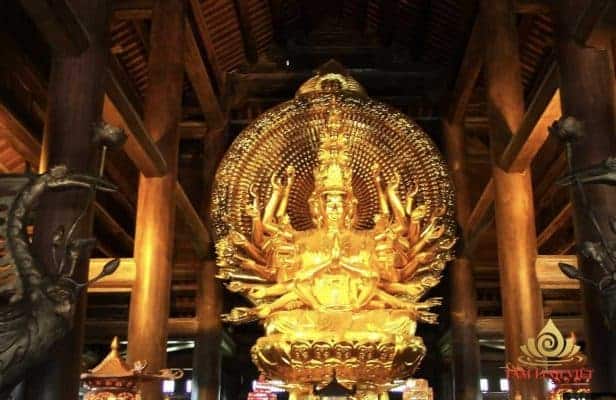 Bodhisattva statue with hundreds of hands and thousands of eyes.
Bodhisattva statue with hundreds of hands and thousands of eyes.
Stupa
The 13-storey stupa is considered the soul of Bai Dinh pagoda. The 13th floor of the stupa is where the Buddha's relics were worshiped from India, Thailand and Myanmar in 2008. Standing here we can see the whole view of Bai Dinh pagoda from above.
 Stupa in Bai Dinh Pagoda
Stupa in Bai Dinh Pagoda
Three Worlds Court at Bai Dinh Pagoda
This temple worships 3 identical statues of Buddha which represent for the past, the present and the future.
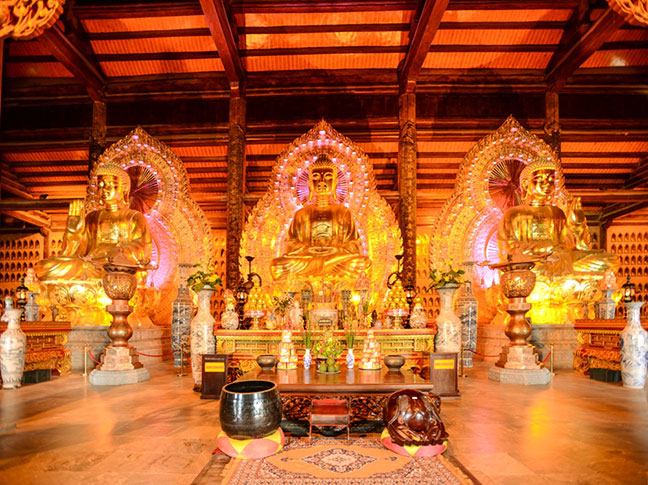 Three Worlds Court at Bai Dinh Pagoda
Three Worlds Court at Bai Dinh Pagoda
Ticket price:
Bai Dinh Pagoda is free to enter but the temple grounds are quite large, we think you should rent a tram with a fee of 60,000 to 500,000 (including English speaking guide).
How to get to Bai Dinh Pagoda?
- Bus: you can go to My Dinh / Nuoc Ngam / Giap Bat bus station in Hanoi to go to Nho Quan or Kim Son bus station in Ninh Binh. Then take a motorbike taxi or taxi to go to Bai Dinh Pagoda.
- Train: Taking the train to Ninh Binh is also an interesting experience. This way, you board the train from Hanoi and get off at Ninh Binh station. From here you can take a bus or taxi to Bai Dinh. Train ticket prices range from 70,000 to 120,000 VND/person, depending on seat class.
- Private car or motorbike: You can easily rent a car in Hanoi. If traveling in a small group, renting a car is the optimal choice for you. You follow National Highway 1A to Ninh Binh city center and then follow the signpost to Bai Dinh Pagoda.
Tip for your AMAZING Bai Dinh Pagoda day trip:
- It is advised to bring along some pairs of sports shoes instead of wearing high-heels or doll shoes to protect the feet and make it convenient for moving as well. Because of the mountain, pagoda climbing will be included in the journey. Visitors may pack formal clothing when entering pagodas. Tourists should wear comfortable clothing, not tight, sweat-proof ones.
- There are many shops selling interesting souvenirs and attractive specialties. However, the price in the mountains is often much higher than that outside. Therefore, to buy local specialties as presents, tourists should go down the foot of the mountains to buy at a cheaper price.
- At the beginning of springtime, it often has drizzle. In case of that, visitors may bring a small carefully-folded umbrella.
- Remember to bring some pence when coming to pagodas and donating. Visitors should avoid putting money on Buddha statues. This behavior can damage the beauty of the pagoda area. Instead, tourists had better donate money into donation boxes.
If you are busy or can not arrange a tour for yourself, we suggest some tours below you can refer to: